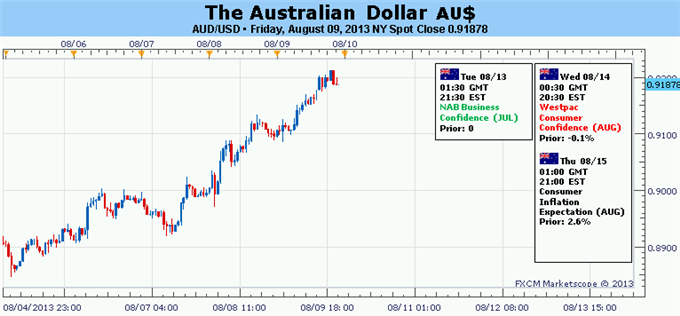
Fundamental Forecast for Australian Dollar: Bullish
AUD/USD Technical Analysis: Looking for Long Trade Setup
Speculative Sentiment Hints Aussie Reversal May be Brewing
Capitalize on Shifts in Market Mood with the DailyFX Speculative Sentiment Index.
The Australian Dollar outperformed last week, adding a hefty 3.4 percent against its US namesake to produce the strongest 5-day rally in 20 months. The move is all the more impressive considering it was produced against the backdrop of an interest rate cut from the RBA and a disappointing set of Employment figures that showed the economy shed 10,200 jobs in July, yielding the worst result in four months.
While traders’ response to further easing was to be expected, resilience following the jobs data is of interest considering the details of the report were not much more encouraging than the headline figure. Full-time and part-time hiring both declined and a slight drop in the unemployment rate seems to have owed to a drop in the participation rate rather than a robust labor market. Furthermore, June’s figures were revised broadly lower.
Such counter-intuitive performance seems to reflect a deceleration in capital flows feeding the Aussie-short trade. Put simply, those market participants that intended to be short at current levels are already there, meaning the down trend is running dry on fuel needed to perpetuate itself. Indeed, while the latest COT data set shows net speculative shorts hit another record high, the week-on-week growth rate of anti-AUD exposure has dramatically declined.
Furthermore, the breakdown in the Aussie over recent months has closely tracked the deterioration in the relative monetary policy outlook, which in turn appears to have emerged as the markets aggressively slashed their outlook for Chinese economic growth. With this in mind, it’s noteworthy that Chinese economic news-flow appears to be stabilizing relative to expectations. If this helps halt the slide in Chinese growth bets, it may likewise scatter calls for further RBA easing in the near term and set the stage for Aussie gains.
Indeed, this dynamic was on full display in price action last week after China released encouraging trade, inflation and industrial production figures.Imports rose by 10.9 percent, marking the largest year-on-year increase in three months and hinting demand from Australia’s top trading partner may be far more resilient than expected. Meanwhile, soft CPI and PPI readings signaled greater room for Beijing to introduce stimulus and Industrial Production posted a 9.7 year-on-year increase, marking the strongest gain in five months.
The week ahead seems to offer a relatively clear path for an Aussie recovery to continue. The Australian economic docket features second-tier event risk and the Chinese calendar is effectively blank. US news-flow is worthy of consideration in the event that speculation about the Fed’s intention to “taper” QE asset purchases produces a strong response from sentiment trends that spills over into AUD price action. CPI, Retail Sales and the University of Michigan Consumer Confidence gauge are all due to cross the wires. The correlation between the Australian unit and benchmark stock indexes (including the S&P 500 and the MSCI World gauge) has unraveled on short-term studies however, hinting the currency may be little-scathed even if risk appetite sours.
DailyFX provides forex news and technical analysis on the trends that influence the global currency markets.Learn forex trading with a free practice account and trading charts from FXCM.
Source: Daily fx